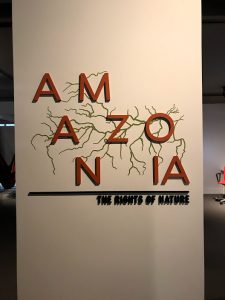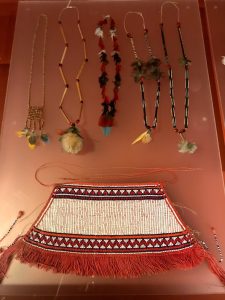Curators and The Difficult Choice
Located at the end of the University of British Columbia (UBC) Vancouver campus, stands a hidden yet striking, large, grey, concrete building that is called the Museum of Anthropology (MOA). In my ASTU 100 class, a first-year Art Studies course, we were given the assignment of visiting MOA, specifically the Amazonia exhibit, and reflect on our visit to MOA through a blog post. The Amazonia: The Rights of Nature Exhibit was curated by Nuno Porto and is located in the O’Brian Gallery in MOA.

Exhibit Sign

View from MOA
When I visited the exhibit, I was drawn to an object – a necklace. The necklace is made out of beads

Necklace: furthest from the right
and hanging at the bottom of the necklace is 3 multi-coloured feathers. The necklace, and the other items surrounding it (anklets, sticks, loins, headdresses, earrings, armbands, aprons, and headbands), were all in a collection called “The Marketplace.” This collection said that in 1977, there was a project in Amazonia that gathered works made by the Indigenous peoples and sold them (Porto). The project was not a huge success; many groups did not want to give their creations while other groups did (Porto). This particular collection in the exhibit illustrates how there were differing views between the Indigenous peoples of Amazonia and how the creations of the Indigenous people preserve the history of their culture and their natural environment.
When I left the exhibit, I thought about my lack of knowledge regarding the multiple Amazonian cultures and the colonisation that took place in this region of the world. I had seen some of the objects in the museum before (the headdresses, necklaces, and earrings) however, I never knew the history behind these creations. The exhibit invited me to consider what I learned about the Amazonian peoples, the exhibit, and what how decision-making was accomplished when choosing what to place in the exhibit and how to arrange the exhibit. I wanted to extend this conversation on the power of choice as curators must make important decisions about what to include in an exhibit and how to arrange the exhibit and each decision impacts the experience of a visitor – whether that visitor has knowledge in the topic or not.
In my ASTU class, we read an article entitled, “Of Things Said and Unsaid: Power, Archival Silences, and Power in Silence” by Rodney Carter. Carter analyzed archives and how they often, unintentionally and intentionally, silence marginalized groups and how sometimes these groups can find power in silence. Carter explains that since Archivists must choose what will be included in the archives, voices will always be excluded (219). Carter is specifically speaking about archives in this article and while there are multiple differences regarding archives and museums, this was article is relevant because of Carter’s emphasis on the choice of what will be included. He stresses that each choice a curator makes has positive and negative results.
There are varying reasons for why curators choose certain items or make these decisions. Art21 compared curators finding pieces to dating by saying that every curator has a different “type” (Brenner). Whereas in other cases, the curators must think about the audience when deciding which items, videos, audio recordings, etc. to include. In Jonathan Allen’s article about curators designing the 9/11 Museum, he draws attention to the difficult choices curators must make when choosing how to create the exhibit. These curators had to choose items and audio recordings from the last moments the victims were alive while trying to create an exhibit that did not overwhelm the public with anguish (Allen). While this seems like an impossible task, the article highlights that curators must curate their exhibit with the audience involved.
Choosing how to arrange and what to add to an exhibit is not an easy task, yet in the Amazonia: The Nature of Rights exhibit each item in every display was placed with purpose and intention. After reflecting on the necklace I described at the beginning and questioning why each specific piece in the exhibit was included, I have concluded that an exhibit should be looked at as a whole and not just each specific piece. While everything in the exhibit was carefully selected, the exhibit as a whole told a complex and important story which is the main mission of the exhibit. Even the description of the exhibit itself insists that “taken in its entirety, the exhibition promises to offer a revealing window into one of the world’s more culturally, socially, and linguistically diverse regions” (Porto).
Works Cited
Advanced Information Sources Cluster. “Archives, Libraries, and Museums Defined.” Archives, Libraries, and Museums, eduscapes.com/cluster/10.htm. Accessed January 28, 2018.
Allen, Jonathon. “Curators Make Hard Choices at 9/11 Museum.” Reuters, Thomson Reuters, 6 Sept. 2011, www.reuters.com/article/us-sept11-museum/curators-make-hard-choices-at-9-11-museum-idUKTRE78558920110906. Accessed January 18, 2018.
Brenner, Mike. “So What ARE Curators Looking for?” Art21 Magazine, 4 Oct. 2010, magazine.art21.org/2010/10/04/so-what-are-curators-looking-for/. Accessed January 18, 2018.
Carter, Rodney G.S. “Of Things Said and Unsaid: Power, Archival Silences, and Power in Silence*.” Archivaria, vol. 37, no. 61, 2006, pp. 215–233.
Museum of Anthropology, and Nuno Porto. “Amazonia: The Rights of Nature.” Museum of Anthropology, University of British Columbia, 27 Mar. 2017, moa.ubc.ca/portfolio_page/amazonia/. Accessed 18 January. 2018.